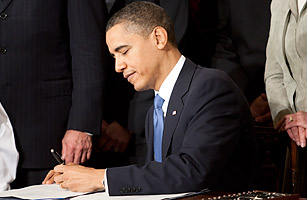
Now for the really hard part.
President Obama's signature on sweeping health reform legislation in the East Room of the White House on March 23 was an achievement for the history books. Yet even though the bill is now the law of the land, the partisan and ideological warfare over it is certain to rage on, both as an issue in the midterm elections and in statehouses across the map. But the success or failure of the whole endeavor is going to ride not on what it does for anyone's political prospects — or their place in history. The new law will be judged on whether it actually fulfills its promise of a better and fairer health care system or instead sends costs spiraling skyward and opens up a world of unintended medical consequences. Obama's team, for its part, admits to no doubts. "I think this will sell itself," says David Axelrod, the President's top political strategist. "The most important thing is that we implement it effectively, efficiently and with great accountability." Senate minority leader Mitch McConnell, meanwhile, says the GOP has an implementation plan of its own: "Repeal and replace."
Economists and health care experts have long agreed on the problems that ail the health insurance system in America. It leaves too many people out. Even those who have coverage may be one diagnosis away from financial catastrophe. On the other side of that same equation lie the waste and excess created by paying doctors and hospitals for the quantity of treatment they provide rather than what works best. By some estimates, as much as 30% of the more than $2 trillion Americans spend on health care each year goes toward treatments that are unnecessary and even harmful. And what does the U.S. get for that staggering investment? Shining hospitals packed with cutting-edge technology but also a population whose health and life expectancy lag behind those of most other industrialized democracies.
Will these reforms turn all that around? We won't know for years, probably not for decades. The most ambitious element of the new health care law — the expansion of coverage to an additional 32 million Americans — won't even take effect until 2014. "It'll take four years to implement fully many of these reforms because we need to implement them responsibly," Obama said as he prepared to sign the legislation. "We need to get this right."
And expanding coverage is just the beginning. Once the U.S. moves close to the long-standing liberal dream of seeing nearly all the nation's citizens guaranteed health care, there are hundreds of ideas for transforming its medical system into something that will be far more efficient and effective. The big question is how well these theories will work in the real world.
You might think a piece of legislation that is more than 2,400 pages long would leave little to chance or the imagination. That is not the case. At the moment, governors in all 50 states are looking at the prospect of having to set up new health insurance marketplaces for small businesses and individuals who do not get coverage at work. As yet, there are only broad outlines to guide them. Says Oregon Governor Ted Kulongoski, a Democrat: "I wake up worrying how I'm going to get from 2010 to 2014."
The bill Obama signed, in short, is far from a finished product. In fact, say health experts, it is only a start. "Of course we'll fuss with it," says Karen Pollitz, who directs Georgetown University's Health Policy Institute. "But we'll have something to fuss with, as opposed to nothing." The trick, however, is this: for any part of this new system to work as well as it should, it all has to. Here are five big elements to watch: